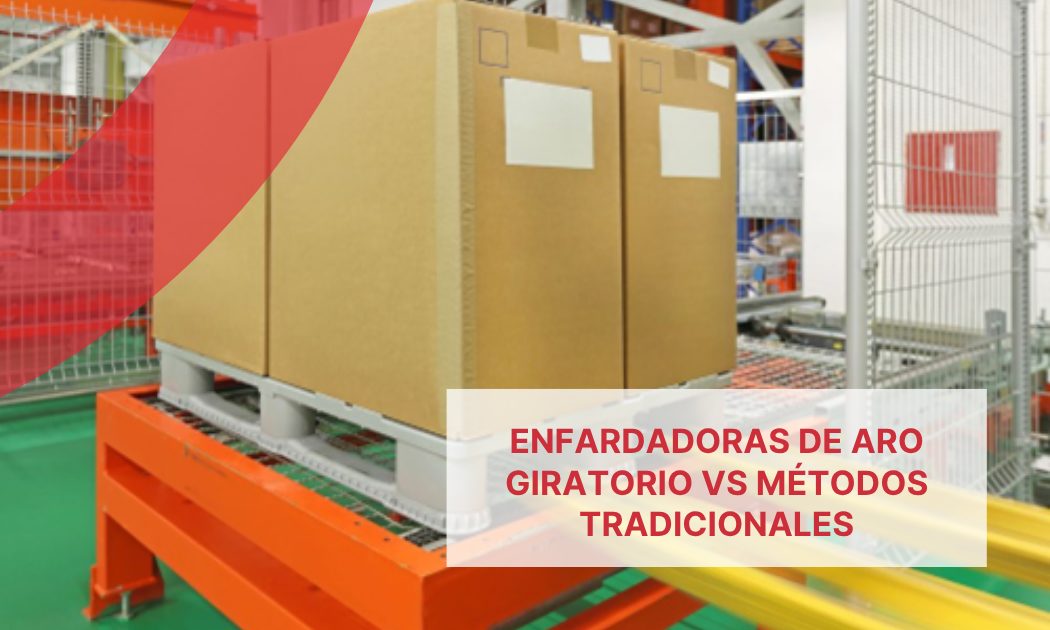Rotary ring wrappers provide significant competitive advantages over traditional methods. And you should be aware of them. Keep reading…
Rotary Ring Wrappers vs. Traditional Methods: Advantages
Rotary ring wrappers are an appealing alternative because they contribute to the automation of wrapping and the distribution of supplies and goods. This system, through an articulated arm, wraps the pallet precisely and ensures its stability. However, not all of the advantages over traditional systems are widely known. Here are the most important ones:
1. Wrapping Time with Rotary Ring Wrappers
Wrapping time is substantially reduced when using automated machines. In fact, manually wrapping a pallet can take more than twice the time compared to using a machine. Additionally, a machine doesn’t tire or need breaks. When wrapping multiple pallets, the time savings from automation are evident.
There are different types of wrappers, and the hourly output varies. Basic models can wrap 50 pallets per hour, while advanced models can reach 160. This is a difference that manual labor simply cannot bridge.
2. Occupational Safety
Safety is another essential factor that makes a difference. A wrapper reduces the risk of workplace accidents. After all, the worker isn’t in direct contact with the load, avoids falls, and is not at risk of strains. If your priority is occupational risk protection, working with machinery is preferable. The lower the margin for human error, the better for everyone.
Even with strict safety policies, automation is still safer than manual labor. So if you want to avoid uncontrollable issues, rotary ring wrappers are the better option.
3. Labor Costs
Labor costs are another specific area where a wrapper offers savings. First, less labor is needed per pallet. Second, the risk of workplace accidents—and therefore sick leave or compensation—is lower. If palletizing is frequent, this alternative becomes worthwhile.
These savings increase with the size of the company because each saved salary reduces overall business costs. From a broader perspective, you’ll likely achieve significant savings.
4. Stretch Film Utilization
Stretch film is used more efficiently with a wrapper than manually. Why? Because you can adjust it to use only the necessary amount by properly tensioning the material. For a single pallet, this may be negligible, but when wrapping hundreds of pallets per month, it becomes a cost to consider.
Of course, the quality of the film also plays a role. But under similar conditions, an automatic machine will help you make better use of available resources.
5. Wrapping Quality
Wrapping quality is another key comparison point between machinery and manual methods. Clearly, automatic methods provide higher quality, with no loose film tails or similar issues. On the other hand, manual wrapping may result in torn film, insufficient tension, or delivery problems.
There’s also the matter of damage from impacts. When using a wrapping machine, protection is enhanced, and the likelihood of such issues is reduced. If you want to prevent damage to the load, this is a good way to minimize risks.
6. Adapting to Market Demands
Mechanization allows for better adaptation to, for example, sudden increases in demand. Wrapping speeds can be adjusted based on real-time needs, and machines can work intensively with more flexibility than traditional methods. In extreme or unexpected situations, it becomes the preferred choice. Today we talk about scalability, and that’s exactly what wrappers offer over traditional approaches.
7. Adapting to Irregular Pallets and Loads
Some loads or pallets, such as granulated products, are unevenly distributed. A rotary ring wrapper can adapt better if properly programmed. A worker could do this manually too, but the risk of accidents is much higher. Being able to adapt to irregular loads is especially important where uniformity isn’t possible. Yes, it requires accurate machine calibration, but it offers more safety.
8. Costs of Wrappers vs. Traditional Methods
Wrappers involve a cost and an initial investment, which may deter some buyers. Obviously, if wrapping needs are small or infrequent, manual wrapping might suffice.
However, two points must be noted. First, the investment pays off in the medium term with even a relatively low number of monthly pallets. Second, failing to adopt new technology may reduce your company’s competitiveness.
Finally, there are companies offering rotary ring wrappers at highly competitive prices—definitely worth considering.
In Summary…
Rotary ring wrappers are valuable because they add efficiency, help your company become more competitive, reduce costs, and increase productivity. They are also available in various models tailored to your industry. For all these reasons, they are a better option than traditional wrapping.
At Movitec, we offer a wide range of solutions. Call us and we’ll provide information about our catalog with no obligation!


